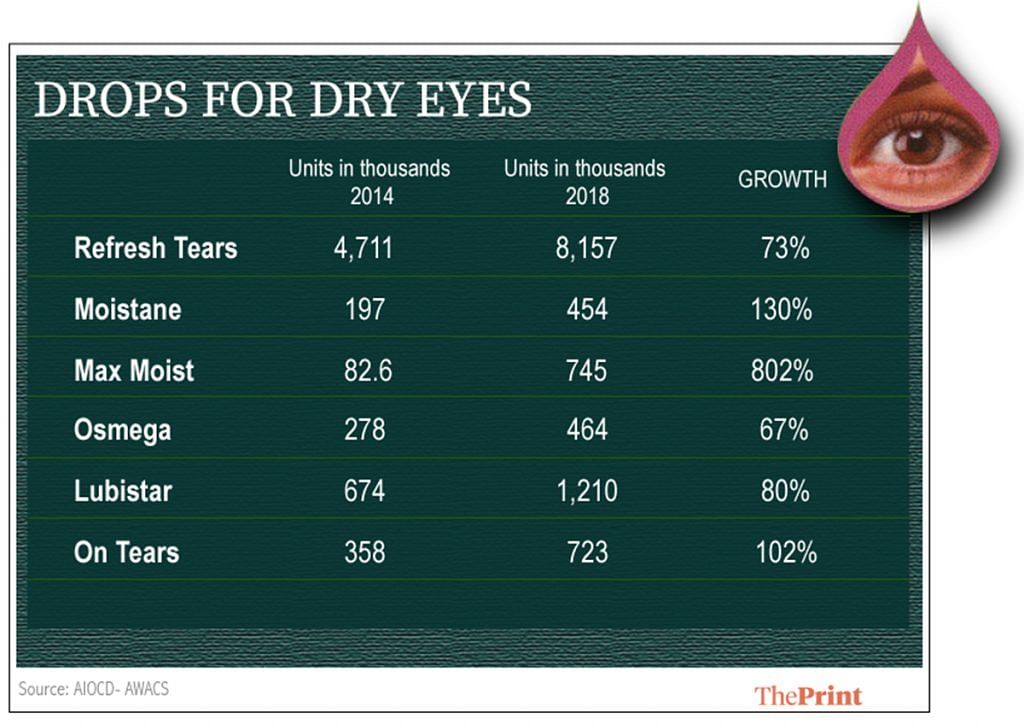Eye drops sales have gone through the roof due to ‘digital vision syndrome’ caused by use of gadgets such as mobile phones & computers.
New Delhi: India is the world’s second largest smartphone market, with more than 42 lakh handsets sold every day during the first quarter of calendar 2018.
But there is something else that is also flying off the shelves because of the surge in the number of smartphone users in the country – eye drops that provide relief from dry eyes caused by excessive use of smartphones, as well as computers and tablets.
Medical experts are diagnosing seven out of 10 patients with ‘digital vision syndrome’, which leads to dry eyes and is believed to be caused by blue-light emitted by these devices. This, they say, has a direct relation to the 54 per cent jump in the overall market for eye drops in the last four years.
At least four of these seven patients are aged between 20 and 30 years and also complain of eye strain, headache, blurred vision, neck and shoulder pain, doctors say.
“In total, we are spending almost 10 hours of our day in front of the harmful blue light. Our ophthalmic out-patient department (OPD) usually has at least 70 per cent of patients suffering from dry eyes. And half of them would be aged 20 to 30 years,” said Aditi Dusaj, senior ophthalmologist, Sri Balaji Action Medical Institute.
A survey conducted by the All India Institute of Medical Sciences (AIIMS) in 2017 found that of 5,000 patients treated at its ophthalmic OPD, 50 per cent suffered from dry eyes, a condition in which the eyes fail to produce enough tears. Of these, 20 per cent of the patients were aged less than 40 years.
Also read: No English? No problem. How non-English speakers in India are using their smartphones
“There is a positive correlation of dry eyes or increasing eye diseases with the use of smartphones and computers,” said Dr. Jeewan Singh Titiyal, professor of Ophthalmology at AIIMS, who oversaw the survey. “While the major reason for dry eyes is our increasing use of mobile phones and laptops, the other reasons include the habit of sitting in air-conditioned rooms, pollution and facial cosmetics.”
Eye drops sales up
Consider this: The sale of the most common medicine for dry eyes – Refresh Tears – has gone up from 4,71,000 units to 8,15,700 units – posting a jump of almost 73 per cent between July 2014 and July 2018, according to data with research firm AIOCD- AWACS.
Brand Max Moist, another used to treat dry eyes, posted an increase in sales from 82,600 in 2014 units to 7,45,000 units in 2018 – an 800 per cent rise.
Moistane, another brand for dry eyes, has grown by 130 per cent after selling 4,54,000 units in the last year against 1,97,000 units in 2014.

To cash in on the growing demand, pharmaceutical companies launched 284 new products in the eye drops category in the last four years. Of those, around 45 products, about 15 per cent, have been launched for the treatment of dry eyes. The rest are used to treat eye infections, eye deficiencies and post-surgical care.
How smartphones and laptops are hurting our eyes
Doctors say digital vision syndrome or computer vision syndrome leads to discomfort in the eye and causes vision problems, and is caused by prolonged exposure to digital screens. The level of discomfort appears to increase with the amount of digital screen use.
In India, a study by research firm eMarketer found that smartphone users will on an average spend 2 hours 39 minutes with their handsets in 2018. Another survey by Acuvue, a brand of disposable contact lenses, determined that an office worker in India spent an average of 6.5 hours a day with a computer or laptop.
Also read: Amazon’s India chief tells employees to shut down email at night, maintain life balance
According to the American Academy of Ophthalmology, viewing a computer or digital screen is different from reading a printed page, in that the letters on digital devices are not as precise or sharply defined, the level of contrast of the letters to the background is reduced, and the presence of glare and reflections on the screen may make viewing them difficult.
Viewing distances and angles used for this type of work are also often different from those commonly used for other reading or writing tasks. As a result, the eye focusing and eye movement requirements for digital screen viewing can place additional demands on the visual system.
In addition, the presence of even minor vision problems can often significantly affect comfort and performance at a computer or while using other digital screen devices.







Technology double edged knife. Side effects highlighted in this article.